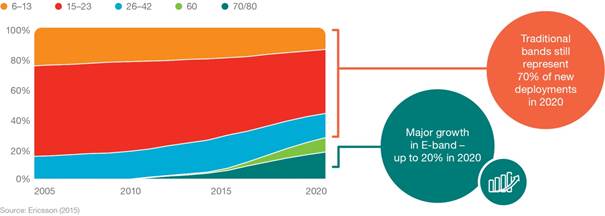Ericsson: E band spectrum key to boosting microwave capacity
- Microwave Towards 2020 reports E band spectrum key to handling fronthaul and backhaul capacity increases
- Report predicts microwave technology will support multi-gigabit (Gb) capacities in traditional frequencies and beyond 10 Gb in the millimeter wave
- Paradigm shift in microwave planning to introduce multiband use
Ericsson (NASDAQ: ERIC) today releases the latest edition of Microwave Towards 2020, an ongoing report series on the state of the microwave business. In the report, Ericsson predicts several major developments by 2020.
Firstly, microwave technology will support multi-gigabit (Gb) capacities in traditional frequency bands and beyond 10 Gb in the millimeter wave (E and V bands). E band spectrum will be key in catering for capacity increases in backhaul as well as fronthaul. In addition, microwave planning will begin to include multiband use.
In the coming years, the choice between fiber and microwave in backhaul networks will not be about capacity, but fiber presence and TCO. Ericsson foresees that microwave will continue to be the dominant backhaul technology. In 2020, 65 percent of all cell sites will be connected by microwave solutions; markets such as China, Japan, South Korea and Taiwan that have existing deep fiber investments will be the exception.

Backhaul media distribution, excluding China, Japan, South Korea and Taiwan
Microwave backhaul technology is already able to handle 100 percent of all radio access sites' capacity needs, both now and in the future. By 2020, the technology will have evolved to support multi-Gb capacities in traditional frequency bands and beyond 10 Gb in the millimeter wave.
Karolina Wikander, Head of Microwave, Ericsson, says: "Microwave networks are a vital ingredient for operators to provide the best possible performance and quality of experience in the most cost-efficient way, and will continue to be the dominant backhaul technology in the future.
"Capacity needs will continue to increase on the road to 5G, and keeping up requires continued technology evolution and re-imagining network efficiency."
E band spectrum will prove key in catering for capacity increases in both fronthaul and backhaul. The E band (70/80GHz) will experience major growth and will represent up to 20 percent of new deployments in 2020. Traditional bands will represent 70 percent of new deployments in 2020.
Ericsson foresees a paradigm shift in microwave planning, with the introduction of multiband use. A seven-time capacity increase can be achieved using a wide, low-availability link in the E band to boost a high-availability link in traditional bands.

New deployment share per frequency range (GHz)
Get more insights - including the pitfalls of the "pizza box" deployment approach and how to save three times the indoor space - in the September 2015 edition of Ericsson's Microwave Towards 2020 report.
NOTES TO EDITORS
New Microwave Towards 2020 report
Download high-resolution photos and broadcast-quality video at www.ericsson.com/press
Ericsson is the driving force behind the Networked Society - a world leader in communications technology and services. Our long-term relationships with every major telecom operator in the world allow people, business and society to fulfill their potential and create a more sustainable future.
Our services, software and infrastructure - especially in mobility, broadband and the cloud - are enabling the telecom industry and other sectors to do better business, increase efficiency, improve the user experience and capture new opportunities.
With approximately 115,000 professionals and customers in 180 countries, we combine global scale with technology and services leadership. We support networks that connect more than 2.5 billion subscribers. Forty percent of the world's mobile traffic is carried over Ericsson networks. And our investments in research and development ensure that our solutions - and our customers - stay in front.
Founded in 1876, Ericsson has its headquarters in Stockholm, Sweden. Net sales in 2014 were SEK 228.0 billion (USD 33.1 billion). Ericsson is listed on NASDAQ OMX stock exchange in Stockholm and the NASDAQ in New York.
www.ericsson.com
www.ericsson.com/news
www.twitter.com/ericssonpress
www.facebook.com/ericsson
www.youtube.com/ericsson
FOR FURTHER INFORMATION, PLEASE CONTACT
Ericsson Corporate Communications
Phone: +46 10 719 69 92
E-mail: media.relations@ericsson.com
Ericsson Investor Relations
Phone: +46 10 719 00 00
E-mail: investor.relations@ericsson.com



